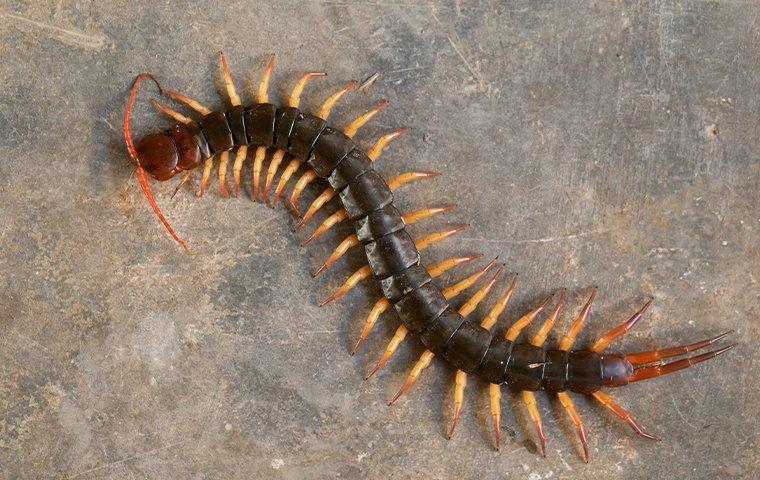 Chances are you’ve probably seen a centipede on your bathroom wall or in the basement. Centipedes have flat, elongated bodies and range in size.
Chances are you’ve probably seen a centipede on your bathroom wall or in the basement. Centipedes have flat, elongated bodies and range in size.
Despite their name, they can have anywhere from 15 to 177 pairs of legs depending on the species, with each segment containing one pair. Centipedes are found in several colors, but brown and reddish-orange are the most common color patterns.
There are different species of centipedes found throughout the United States; many are found outdoors, living in dark, damp spaces such as under logs and stones. A few species, like the house centipede, may be found inside the home, living in damp areas like basements, closets, and bathrooms.
House centipedes are active hunters meaning they feed on silverfish, roaches, spiders, moths, flies, and even termites. While harmless to humans, if you frequently find house centipedes in your home, it may be a sign of a bigger pest problem.
What Are the Signs of House Centipede Infestation?
House centipedes don’t leave any evidence that indicates they are in your home. Instead of building a nest or colony like ants or termites, they find a new hiding place each day.
You are most likely to accidentally find a house centipede resting on the wall, trapped in a sink or bathtub, or quickly coming out of their hiding spot to find another spot.
Centipedes feed on other insects such as ants, spiders, bed bugs, roaches, and silverfish. If you have seen any of these pests in your home, you may be dealing with house centipedes as well. To get rid of house centipedes in your home, you want to thoroughly clean damp areas of your house like the basement or attic and remove their potential hiding places.
How to Prevent House Centipedes
House centipedes are harmless but can be a nuisance when you find them in your bathroom. To help prevent future house centipede problems inside your home, there are several things you can do:
- Reduce Moisture: House centipedes prefer moist, high humidity environments to live in. Eliminate damp areas by repairing water leaks, using a dehumidifier to keep the basement dry, and run exhaust fans in the bathrooms and attics to prevent excess moisture from developing.
- Remove Clutter: House centipedes will seek out spaces that provide protection and cover. Reduce the clutter in the basement, crawlspace, and attic to limit their ability to hide. Outside, move piles of leaves, grass clippings, and firewood away from the house.
- Eliminate Their Food Source: Controlling other insects and spiders inside your house will also control house centipedes since their diet consists of other insects.
- Seal Entryways: Seal holes, cracks, and gaps around the outside of your home to keep house centipedes and other insect pests from getting inside. Also, repair tears in screens and even add weather stripping to doors and windows to keep unwanted pests out.
Rid-A-Bug Centipede and Pest Management
If you notice signs of insects or pests, you may also have a house centipede problem. Contact your local Rid-A-Bug pest management professional and request an inspection. Once the inspection is complete, we will prepare a centipede treatment solution designed to control the house centipedes and other insects causing problems. Visit our website for more information about our pest control services.